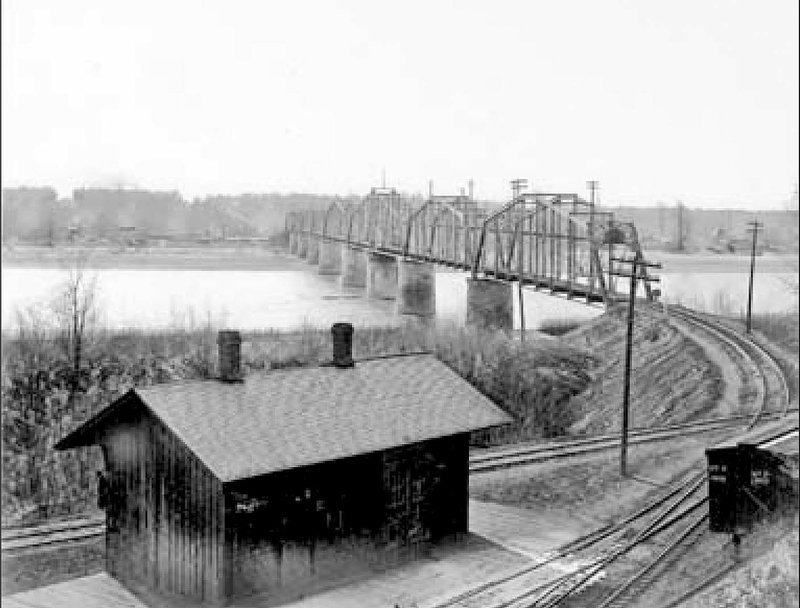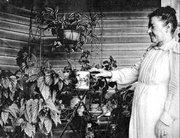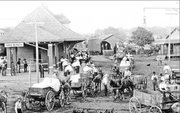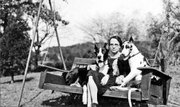Tom Wing knows Van Buren.
He knows the name of Caroline Mary Scott's Great Dane was Lady Polka Dot.
He knows the Missouri Pacific Railroad in the early 1900s operated a roundhouse and turntable in the city to repair locomotives and cars.
And he knows, that for filming of the 1995 western film Frank and Jesse, the pavement of Main Street in Van Buren was covered with dirt, returning the historic downtown to the 19th-century community visited by the outlaw band led by brothers Jesse and Frank James.
Arcadia Publishing of South Carolina made the right choice to author the Images of America volume about Van Buren. Wing serves as an assistant professor of history at the University of Arkansas-Fort Smith and director of the university-owned Drennen-Scott Historic Site, and he starts the book with a brief but complete history of Van Buren in the introduction. He then included chapters on transportation, natural disasters that devastated parts of town, Main Street and historic homes and people important to the town which stands on the north side of the Arkansas River.
"From prehistoric times to the present, the site of Van Buren has seen a constant flow of goods, services, raw materials and agricultural products move in every direction," Wing concluded the book's introduction. "In earlier times, people have traveled by foot, horse, boat and rail, but more recently, cars and trucks testify to the value and significance of the interstate system. All the movement and economic activity described here and chronicled in these photographs tell the story of Van Buren: survivor of war, floods and tornadoes, that is river town, rail junction and crossroads of a nation."
BUILDING BRIDGES
But in research for the book, Wing discovered he didn't know it all.
"I learned a lot about building bridges when writing that chapter," he said. "The railroads came in the 1870s, but the bridge was not completed until 1885. For 10 or 15 years, a ferry shuttled two or three cars at a time across the river."
"The railroad first came to Van Buren in 1876 with the opening of the Little Rock and Fort Smith Railroad," Wing recorded in the book. "Transfer across the river was accomplished by the use of a double-ended side-wheeler (steamboat), the Harold B. In 1882, the Saint Louis-San Francisco Railroad Company (the Frisco) established service through Van Buren and Fort Smith. The side-wheeler transfer across the river continued for only a short time due to increased traffic and demand.
"In 1885, the Fort Smith and Van Buren Bridge Company was created to remedy the situation and completed the bridge a year later," the book reads. "The chief of engineers for the U.S. Army declined the first two proposals for the bridge, citing location, bridge height and current of the river. A compromise was eventually reached."
The Van Buren installment of Images of America presents a detailed photographic record of the construction of the bridge, from early surveyors outside the construction office to a 1920s picture looking south over the bridge taken from the front yard of the Drennen-Scott house.
"John Drennen, who founded Van Buren, owned the land surrounding the ferry landing and sold it to the railroad," Wing said.
The pictures of the bridge construction were most recently in the collections of the Cornell Railroad Historical Society, according to Wing. Society staff contacted Hawkins Weir Engineering in Fort Smith, and Larry Weir shared the pictures with Wing in 2004. Wing, in turn, used high-resolution enlargements to see fences and gardens around the Drennen-Scott house and was able to restore parts of the house and yard from those photographs.
"Looking at the pictures of the river from the Fort Smith side, I noticed the bridge was in a straight line with the Drennen-Scott house (which stands on a bluff above the river)," Wing said. "It only made sense to use them in the book. They've never been published, and they are old enough to be in public domain. You can see the clock tower of the Crawford County Courthouse, the skyline of Van Buren.
"But I'd had enough of railroad bridges," Wing said. "The book has layers and layers of other interest."
'COMING TOGETHER'
"Van Buren is beloved for the places in the community where residents can come together," Wing wrote at opening of chapter 3, appropriately titled "Coming Together."
"Whether it be on the streets of the city's scenic downtown, at the county courthouse, in a house of worship, or at a final resting place, citizens have a deep sense of pride and responsibility for the places where they commune," the book reads.
Many of the photographs in this chapter came from a collection by Ora Smith, a 1920 graduate of Van Buren High School who later became a history teacher in Fort Smith. Smith lived in the Wilhauf house, probably the second-oldest house in the city, which UAFS acquired last year. She left the house and her photographs and papers to Zoe and John Cobb, who gave them to the school.
"She would take pictures of all the historic homes in Van Buren, churches, downtown, Main Street ...," Wing said.
The chapter's collection also includes a 1930s postcard, printed by the city's newspaper, that shows downtown Van Buren and a stamp of native son and movie star Bob Burns; a 1970 view of Mount Olive United Methodist Church, built by former slaves and listed on the National Register of Historic Places; and the stately home of John J. Izard, president of the People's Bank and Trust Co., for whom an elementary school was named because of Izard's 46 years of service on the Van Buren School Board.
And the Van Buren junior class photo of 1920, shown on page 28, includes Smith.
The book also takes a look at local mysteries in the second chapter, "Origins Unknown."
"The photographs in this chapter are something of a mystery," Wing wrote. "They were first captured on glass as early as 1903 and were reproduced and redeveloped digitally in 2014."
Wing explained that Ray Wallace, an award-winning photographer and former provost of the University of Arkansas-Fort Smith, found 80 glass-plate negatives in a box at a Fort Smith antiques store in 2013. He bought them and scanned each, creating digital images. Historical interpretation students at UAFS helped with research and identification, using clothing styles, magazine dates and some furnishings to determine approximate dates for the collection, Wing said.
But many faces remain anonymous -- from a successful duck hunter to a woman watering her plants with a re-purposed coffee can to sisters dressed up as if for a special event and holding bouquets of mums.
"While individual names are not known, the glass-plate negatives and the prints seen here give an interesting -- yet somewhat mysterious -- look at a Van Buren that has long since changed," Wing said.
About two weeks after the book came out in late March, one of the mysteries was solved. Wing received a phone call from Charlotte Faber Bendt, 97, who grew up in Van Buren but left to study dance "and never came back," Wing explained. But she still takes the local paper and watches activity in the Fairview Cemetery, where relatives are buried.
"'I love this book!'" Wing quoted Bendt. "'And I'm going to make your day.'"
On the cover of the book, an unidentified man sits on the bluff at Mount Vista, Wing explained. Bendt identified him as her father, Henry Faber, who ran a grocery store on Main.
"And hanging from his pocket (in the picture) is the chain on which he held his pocket watch," he continued. "She has that chain! She's going to send me pictures of the watch and fob."
NAN Our Town on 06/01/2016




